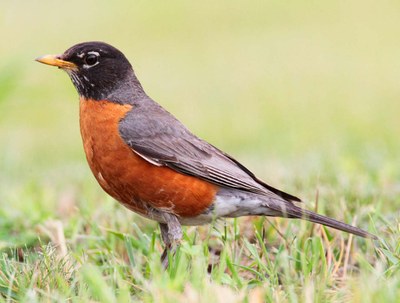American Robins
April 2022
By Ranger Amy
As a San Antonio native, a city girl, I hold my nature memories close. The first bird I ever identified was the American robin.
In 6th grade, my girlfriends and I would gather on the steps of a sidewalk that ran from the main 6th-grade building to the mobile classrooms. We'd "hang out" until the bell rang for school to start. I was always the first one there since my parents had a long work commute.
 Sitting on the step one chilly fall morning, I noticed lots of medium-sized birds with red breasts running in the green fields. There were at least 50 birds, if not more. They would run, fluff their feathers, look around, peck at the ground, and repeat.
Sitting on the step one chilly fall morning, I noticed lots of medium-sized birds with red breasts running in the green fields. There were at least 50 birds, if not more. They would run, fluff their feathers, look around, peck at the ground, and repeat.
I thought about how adults would say, "the early bird gets the worm," and chuckled. There were actual early birds that got worms, who knew! When my friend, Mary-Helen, showed up, I showed her the birds and asked if she knew what they were. She didn't, nor did any of my other friends.
My mind replayed the scene of those birds running in the field throughout the school day. I recall writing a teenage angsty poem about them. When I got home, I went through my mother’s bird book, analyzing each picture until I found the bird, the American robin.
The next morning, I shared my knowledge with my friends and told them that robins are migratory. They're here because the seasons are changing.
Harbinger of winter in Texas
Since that discovery, I have always noticed robins in the fall and winter. At MDJSP, and at my home in the country, robins are abundant in the winter. They surround my house. They squawk when hiking the park trails. They gorge on berries and poop out beautiful dark purple guano full of seeds.
This year was different. I didn't see hundreds of robins in my yard or flocks flying from tree to tree in the park. Where were they?
I thought the winter was mild, so they didn't come as far south, but now I've learned that they don't always migrate south if they don't need to. If food is abundant where at their winter home, they'll stay there.
So, this year I saw very few robins, but it's not predictive of how future falls and winters will be. I missed seeing the robins this year, but perhaps I'll see them next fall. Until then, I'm enjoying welcoming back our summer birds from their winter migrations.
Learn more about robin migrations at Ask Kenn: Are American Robins Really a Sign of Spring?
